There’s no shortage of kayak outfitters helping New Yorkers get out on the Hudson. Several of them will even do it for free. But of those, few allow you more than 15 minutes on the water. Even fewer will let you paddle beyond a netted square along the shore, the boater’s equivalent of a kiddy pool.
And then there’s the Inwood Canoe Club, founded in 1902 and the oldest canoe and kayak club in New York City. Between Memorial Day and Labor Day, the organization runs 45-minute trips every Sunday for a voluntary donation. Depending on the current and tide, thrill-seekers can cruise downstream just short of the George Washington Bridge or past the Harlem River into Spuyten Duyvil in the Bronx.

The first bunch of boats leaves at 10:00 a.m. and can accommodate about 15; aim to arrive by 9:30 to ensure yourself a spot. On clear sunny mornings when there are plenty of prompt, sunblock-slathered faces at the ready, the club’s volunteers have been known to take on another two or three trips, but they make no promises.
The experience begins with a basic paddling lesson: teaching boaters how to move forwards, backwards, and make turns. Whether you’re still looking for your sea legs or trying to contain your memories of summer camp glory, be on high alert in these waters—think big pond, little fish. If you show the slightest signs of floundering, they’ll have to cut the entire group’s excursion short for fear of getting you in over your head—literally.
Once you get comfortable out on the river, there is nothing comparable to paddling past New York City from the vantage point of your kayak on the Hudson. (Waterproof cameras are advised.) Shrouded by tufts of green, the urban grid looks as though it’s been reclaimed by wilderness; only a few buildings break through the canopy. Columbia University’s athletic campus seems odd and out of place while the Cloisters appears to have risen out of the forest organically. On the water, signs of industrialization are more apparent, though almost entirely silent. The bridge hangs in the distance, an ironic border between you and the commercial waters beyond it.
Paddling requires a focus on everything and nothing at once. The burn and the relaxation. The absence of smell. The impossibility of interruption. No vendors, no signs, no streetlights. Just you, your kayak, and the wrinkles of water lapping against the side of your boat.
How to get there: Take the A or 1 train to Dyckman Street, walk west along Dyckman to the marina. Before the gates, follow the gravel trail on the left for 100 feet. Inwood Canoe Club is the red boathouse on the right, 100 yards south of Dyckman.
Photos: Mark Handy (Inwood Canoe Club), This is Emily



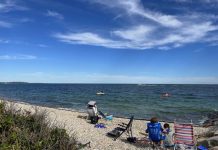
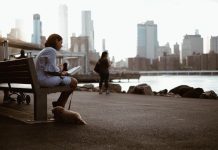





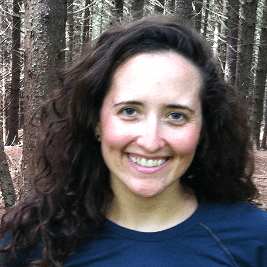 Sarah Knapp is a Brooklyn based entrepreneur whose love for the outdoors and community building led her to the October 2013 creation of OutdoorFest. She has a BA in History, is a Wilderness First Responder and a NY state hiking, camp and boating guide. Her proudest achievement to date is reading the Aeneid in Latin.
Sarah Knapp is a Brooklyn based entrepreneur whose love for the outdoors and community building led her to the October 2013 creation of OutdoorFest. She has a BA in History, is a Wilderness First Responder and a NY state hiking, camp and boating guide. Her proudest achievement to date is reading the Aeneid in Latin. 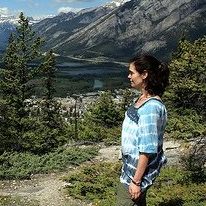 Allison was one of our first top writers and Chief Editor but is no longer working with offMetro. Allison is a native New Yorker, who has lived in Rome, Tuscany, Melbourne, Toronto and Los Angeles. She frequently contributed travel pieces to Family Travel Forum, using her own children as guinea pigs as they travel the globe. She never missed a chance to sample local delicacies, as her love for travel goes hand-in-hand with her love for food and wine.
Allison was one of our first top writers and Chief Editor but is no longer working with offMetro. Allison is a native New Yorker, who has lived in Rome, Tuscany, Melbourne, Toronto and Los Angeles. She frequently contributed travel pieces to Family Travel Forum, using her own children as guinea pigs as they travel the globe. She never missed a chance to sample local delicacies, as her love for travel goes hand-in-hand with her love for food and wine. 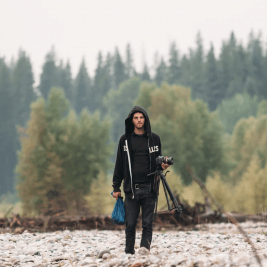 Josh Laskin is a freelance travel writer and photographer based in the White Mountains of New Hampshire. When he is not at work or on the road, you can find him in the mountains snowboarding, climbing, hiking, fly fishing, mountain biking, and eating bagel bites.
Josh Laskin is a freelance travel writer and photographer based in the White Mountains of New Hampshire. When he is not at work or on the road, you can find him in the mountains snowboarding, climbing, hiking, fly fishing, mountain biking, and eating bagel bites. Annie is a travel writer, environmentalist, and surfer based in Venice, CA. She heads up our West Coast team, keeps our grammatical errors in check, and makes sure our California writers always have a plan for their next adventure. Follow Annie’s travels @annelisemcb.
Annie is a travel writer, environmentalist, and surfer based in Venice, CA. She heads up our West Coast team, keeps our grammatical errors in check, and makes sure our California writers always have a plan for their next adventure. Follow Annie’s travels @annelisemcb. Carly Pifer is a freelance writer who has been known to follow whims inspired by romantic movie scenes or colorful street style shots to India, Japan, Tunisia and Argentina. After stints living in Seoul, Boston, Paris and Los Angeles, writing and searching for something intangible, she landed somewhat steadily in Brooklyn and has begun to find inspiration in her more immediate surroundings.
Carly Pifer is a freelance writer who has been known to follow whims inspired by romantic movie scenes or colorful street style shots to India, Japan, Tunisia and Argentina. After stints living in Seoul, Boston, Paris and Los Angeles, writing and searching for something intangible, she landed somewhat steadily in Brooklyn and has begun to find inspiration in her more immediate surroundings.  Kate E. O’Hara is a New York based freelance writer and photographer who loves all things food—especially the people who make it and market it. Her writing aims to capture the essence of the food experience; the stories that go well beyond a plate of ingredients. In addition to her love of food, Kate is also known to have a hankering for red wine and craft beer. You can also find Kate on Instagram
Kate E. O’Hara is a New York based freelance writer and photographer who loves all things food—especially the people who make it and market it. Her writing aims to capture the essence of the food experience; the stories that go well beyond a plate of ingredients. In addition to her love of food, Kate is also known to have a hankering for red wine and craft beer. You can also find Kate on Instagram